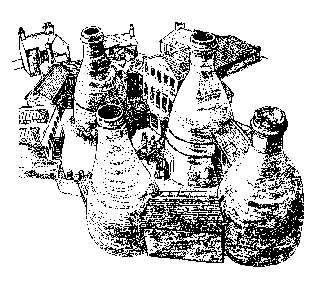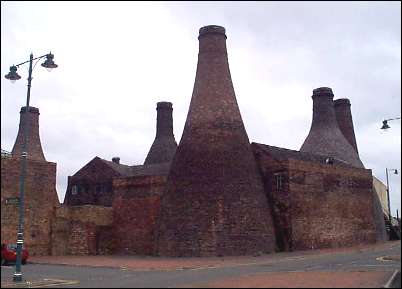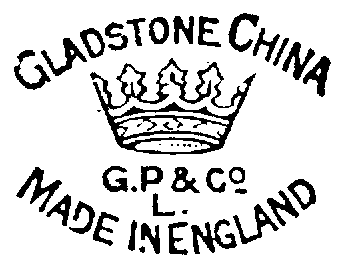George Procter - Gladstone
Pottery,
High Street (now Uttoxeter Road), Longton.
 |
The origin of the pottery known as the Gladstone Works dates right back to the birth of the pottery industry as we know it today. At the end of the 18th century Longton was the next largest pottery pottery town after Burslem, and the future growth of Longton was made possible by the sale of the Longton Manor estate in the 1780s, which enabled the Burslem potters, and others, to buy land at a time when there was a shortage of developable land in the Burslem area. |
Among the purchasers of the Longton lands were the Shelleys, a local family who had become well known for their potting skills. By 1787 they had established a large and thriving manufacturing concern on a site to the south of Lane End, adjoining the recently turnpiked road to Uttoxeter. It is on part of this site that the Gladstone Pottery Museum now stands. Here the Shelleys produced their own earthenware, and also decorated plates and dishes manufactured by Josiah Wedgwood at Etruria. Two of the family, Thomas and Michael, were to achieve considerable prestige as manufacturers; yet by 1789 their business had failed, and they were declared bankrupt and forced to sell their factory. The purchaser was William Ward and he paid £900 for the site.
![]() William Ward had less grandiose ambitions and split up the site into two smaller
potbanks. This division of the Shelleys’ property is still in evidence today,
for the Gladstone Pottery is part of the Ward purchase; the Park Place Works
(now the Roslyn Works) , which lies adjacent to Gladstone, forms the other part
of the original Shelley property.
William Ward had less grandiose ambitions and split up the site into two smaller
potbanks. This division of the Shelleys’ property is still in evidence today,
for the Gladstone Pottery is part of the Ward purchase; the Park Place Works
(now the Roslyn Works) , which lies adjacent to Gladstone, forms the other part
of the original Shelley property.
![]() There is a map
dated 1815 which shows the potbank split into several small lots. Many of these
ranges of buildings were incorporated into later phases of building work in the
19th century, so visitors to the Gladstone Pottery Museum today will be, at
least in part , surrounded by the fabric of 18th century buildings.
There is a map
dated 1815 which shows the potbank split into several small lots. Many of these
ranges of buildings were incorporated into later phases of building work in the
19th century, so visitors to the Gladstone Pottery Museum today will be, at
least in part , surrounded by the fabric of 18th century buildings.
![]() It was in 1818
that Ward sold his potbank to John Hendley Sheridan for £1222. During the next
40 years the development of this potbank was remarkable, and at the same time
very typical of the development of Longton and the industry in the Potteries.
It was in 1818
that Ward sold his potbank to John Hendley Sheridan for £1222. During the next
40 years the development of this potbank was remarkable, and at the same time
very typical of the development of Longton and the industry in the Potteries.
![]() Sheridan himself rose from a relatively obscure background to become a major
civic official in the Borough of Stoke-on-Trent. He let out the potbank to
tenants and seems to chosen entrepreneurs who, with his assistance, enlarged and
modernised the whole factory site. In 1818 the premises consisted of two houses
fronting the High Street, (Uttoxeter Road), with a range of simple workshops and
a kiln to the rear.
Sheridan himself rose from a relatively obscure background to become a major
civic official in the Borough of Stoke-on-Trent. He let out the potbank to
tenants and seems to chosen entrepreneurs who, with his assistance, enlarged and
modernised the whole factory site. In 1818 the premises consisted of two houses
fronting the High Street, (Uttoxeter Road), with a range of simple workshops and
a kiln to the rear.
![]() This
arrangement, with the Master’s house at the front of the property and
workshops and only one kiln at the back was typical of the more modest
manufacturing concerns in the Potteries at this date. Sheridan seems to have
erected for his tenants extra kilns and workshops, completing a form of
courtyard development which is clearly visible in a plan of 1840.
This
arrangement, with the Master’s house at the front of the property and
workshops and only one kiln at the back was typical of the more modest
manufacturing concerns in the Potteries at this date. Sheridan seems to have
erected for his tenants extra kilns and workshops, completing a form of
courtyard development which is clearly visible in a plan of 1840.
| The most daring of Sheridan’s tenants was one Thomas Cooper. It is to him that we owe the present appearance of the potbank. Evidently under Cooper the business thrived; by the 1850s he was employing 41 adults and 26 children in the production of china and parian figures. In 1853 he purchased the master’s house in Chadwick Street. In 1856 he demolished the old houses fronting the High Street; rebuilding followed at once. A Deed of Second Mortgage between Thomas Cooper and John Hendley Sheridan dated 7th February 1857 refers to the two newly built houses and workshops against the High Street.... ‘at present unfinished and unoccupied...’ | 
Photo taken S. Birks (October 1999) |
Evidently the period of successful expansion was relatively short-lived, for by 1876 the site had passed into the hands of Hobson and Co. It must have been at this period that the Works were called after the famous politician W E Gladstone. He came to Burslem in 1863 to lay the foundation stone of the Wedgwood Memorial Institute, and this works has been called the ‘Gladstone Works’ ever since.
Advertisements in the Pottery Gazette show a rather fanciful view of the Gladstone Works when it belonged to R Hodson & Co (1879-1885). From this time on there was a family link between successive owners of the site, and all seem to have made bone china. Procter, Mayer, and Wooley were the owners between 1885 and 1892 and George Procter and Co from 1892 to 1939. George Procter died in 1910 and a detailed inventory of the site was made for his daughter and grandson , also called George Procter.
| From 1939 the company was called
Gladstone China (Longton ) Ltd, under the same management. During the
Second World War Gladstone China closed temporarily and the business was
‘nucleated’ concentrated with the firm of Thomas Poole who had been
granted a government license to continue production. (George Procter was
married to Thomas Poole’s daughter).
|
 |
| The two companies merged in 1952 to be called Thomas Poole and Gladstone China. Thomas Poole and Gladstone China bought up the land around the works including the White House and the Vulcan Public House and obviously intended to expand. It may have been the Clean Air Acts of the late 1950s which forbade the use of the coal firing bottle ovens which required them to concentrate their investment on the core factory of Thomas Poole - the Cobden Works. It was in March 1960 that the ovens last fired; but decorating and then only despatch departments were active until May 1970 when Thomas Poole and Gladstone China put the works up for sale. |
The information on this page is largely from the Stoke-on-Trent museum Internet site - which you must visit if you are interested in Staffordshire pottery.
![]()
![]()
![]()
![]()
![]()
![]()
questions/comments? email: steve
birks
![]()